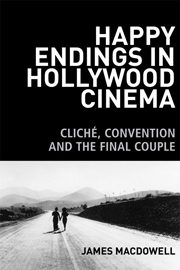2 - Happy endings and closure
Published online by Cambridge University Press: 05 October 2013
Summary
Happy endings are commonly treated as synonymous with closure, and final couples are commonly regarded as synonymous with happy endings. The logical extension of these assumptions also holds, meaning we often come across claims to the effect that Hollywood films tend to be ‘closed by the […] heterosexual couple’ (Russell 1995: 6); likewise, Strinati speaks of closure entailing ‘the coming together of the male and female leads in a romantic happy ending. This is a ‘closed’ narrative' (Strinati 2000: 217); Hayward, meanwhile, offers the simple dictum that, in Hollywood cinema, ‘closure means a resolution of the heterosexual courtship’ (2006: 83).
Final couples have certainly historically served an important role in the conclusions of a great many Hollywood movies, and part of this role has been to make a ‘contribution towards narrative closure’ (Mulvey 1989: 33). This much is undeniable, and will be explored in more depth in this chapter. It is also important, however, to offer a number of caveats to this rule of thumb. One of my aims here is to demonstrate that the final couple by no means always guarantees the same degree or kind of closure; another will be to attempt to present a more multifaceted picture of closure itself by drawing attention to factors that may contribute to its creation or repudiation, but which can often go ignored in discussions of the subject.
- Type
- Chapter
- Information
- Happy Endings in Hollywood CinemaCliche, Convention and the Final Couple, pp. 57 - 97Publisher: Edinburgh University PressPrint publication year: 2013

